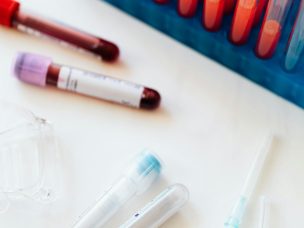Question: If a hospital is not equipped to do that study, how do doctors advocate for that? What kind of strategies have you seen to make sure those patients get care? And How can patients advocate for themselves to make sure that they get the proper tests that they need?
Answer: So it really is referrals, making sure that they can actually be their own advocate. I think this is the day and age of technology, social media, and you see more patients being advocates for themselves. And so I think that’s really, you know, they learn or have more of an inclination that this is what’s going on, then a lot of times the patients aren’t being their own advocates and saying, Hey, I would like to see this doctor, I would like to go to this institution, where these tests can actually be performed. So I think that is kind of one way. I think, again, we see the disparities, just even in the inner city of Chicago, where a lot of different institutions do not have access to the right infrastructure, let alone the shortage of physicians to actually diagnose properly. So making sure that you can actually refer out, I don’t see anything wrong with referring out where patients can, you know, get the care that they need.
Question: What are some of the cultural and kind of systemic hurdles that doctors might face in trying to either, you know, advise patients on courses of treatment, since there might be mistrust of the medical system? What are some of the, you know, cultural and structural things that you often come against when you’re trying to give treatment?
Answer: I think part of the success of treatment is being close to a health care system, where they can provide you with appropriate care, you have to have health literacy to understand what the disease means, and then how to go about the treatment and side effects of treatment, you need family support and caregiver eligibility. The financial aspect is very important here, because not only are they going through a very intense course of treatment, they’re off work for the most part. So on one side, they are paying more money on the other side, they are getting less income.
That’s all it will boil down to. And there are some, I would say, pretty misunderstanding of involving patients in research, I would say just it’s part of how we advanced Medicine. Patient when you tell them, I’m going to consider you for research. First reaction is to say, Please don’t put me on a placebo. This all would contribute to getting appropriate care.
And I would agree with everything that Dr. Kelta is saying, I think one of the limitations that we see is really enrollment in clinical trials. And we know that for instance there’s been a major push to put more minorities on clinical trials. There’s a lot of reasons why that is not happening. There’s a lot of reasons why there is a lot of mistrust for physicians. And I mean, we can even just talk about even recent COVID dynamics and whether or not to get a vaccine. There’s a lot of mistrust about all of this. I can talk about a patient I just had yesterday who actually had multiple myeloma, and she did not want to be on Revlimid, because she got a PE, and she blamed it on the Revlamid but she actually had COVID as well. And so what we know also about COVID is that there’s an increased risk of thrombotic events. And it took a lot of coaching and prodding and saying, Hey, you’re actually on a blood thinner, I think it would be okay to be on Revlimid, because we should start from scratch and have you on a treatment that may actually work. And so I finally convinced her to actually decide to actually get treatment. So it’s, it’s having a relationship with your provider, being able to identify with them. I think I have a good relationship with a lot of my patients and so there’s a lot of trust that has eventually developed. So there are a lot of different factors that I would say why this isn’t happening or why it is happening.
I wanted to add, if you look at the participation of African American and Hispanic in medical research, I will say I came across some figures that cite 5%. So let’s say if you have a study where you have 5% of minorities participating. It’s difficult to apply this research on everybody while you have only the participation of 5% minorities.
Say you have 5% participating in research, but you may have 14%, who actually have the diagnoses or even fewer who are actually donating their bone marrow. So that’s a big problem when you’re talking about advancing treatment for this population?
Question: Are there strategies that you would give doctors in having those difficult conversations with their patients? What have you seen as far as how you approach the conversation? How do you carry yourself in the room that helps you know, patients kind of come to a place of trust and understanding to trust you as a provider?
I would say, for me, it’s just really being authentic and being who you are, I am very approachable with my patients half the time I’m not even in a white coat. And that is for that reason, because they feel comfortable actually seeing me. And with that being said, you know, there is a relationship that is built with these patients, I think having a long standing condition, such as a cancer, I mean, you have a really long relationship, long building and lasting relationship with the patient. And so, you know, from the moment that they’re diagnosed, if they feel that they can trust you, they’re more inclined to kind of do what you say, right? To get involved in research, to you actually go ahead with the treatment options and not really be skeptical? And that’s because of the relationships that you built?
When they come up with a first interview, I think the first impression is very important, you know, your relationship with patients, and his caregiver and his family and loved ones is very crucial. They are overwhelmed, they are, you know, devastated by times with the diagnosis. So they may not capture all of what you tell them. And it will take some time and more communication. And it’s not one time and done. You have to re-emphasize on those important issues and make sure you establish good rapport with the patient and their families. So then it would be easier to relay your messages what what’s important in life and how to focus on those.
So with me being a woman of color, I tend to go out in the field, I’m in the trenches, and I am very involved in a lot of community organizations and so I do a lot of talks. I actually get a lot of my referrals based off of patients, patients’ friends, family members, churches, whomever and so, I think that is definitely one of my strategies in actually being an advocate for patients and having them be able to identify with someone like myself.









